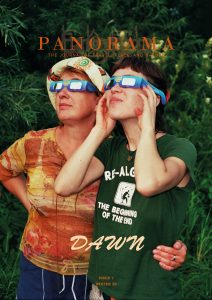Halfway through a six-hour journey through rural Bangladesh in 2007, I realised that I might be missing a piece of myself. We were going over spreadsheets, making phone calls, and preparing for the meeting we were travelling to; the same things we’d be doing if we were sitting in downtown Dhaka. The car was an extension of my office, just as my hotel room was an extension of my office; and just like that identikit international hotel, the car gave me a strong sense of deja vu.
Every war zone I worked in was different; every natural disaster I responded to was different; but one thing was always the same. When I arrived at the airport, when I ventured into “the field,” when I evacuated the country, I was always driven in a white SUV, usually a Toyota Land Cruiser, with my organisation logo on the side. The Land Cruiser was a technology that enabled me to reach places that I could not otherwise reach (in this case, the Bangladeshi countryside after Cyclone Sidr had wreaked havoc on it). But it was more than just a ride.
I found it strange that aid agencies used exactly the same type of vehicle in cities with perfectly good roads as they used in rural environments where everybody else was driving a decades-old sedan or a beat-up minibus. All these Land Cruisers were doing something more than just taking me from point A to point B. It was something that Rebecca Solnit caught sight of in Wanderlust when she wrote: “the auto-prosthetic is for a conceptually impaired body or a body impaired by the creation of a world that is no longer human in scale.” The only question was: what impairment were we all suffering from?
We can agree that aid workers need some form of transport. A 2007 white paper from the Kjaer Group estimated that the sector was then deploying 130,000 4x4s, with annual operating costs of around $1 billion; replenishing this fleet required 20,000 new vehicles at a cost of $700 million per annum. Nobody knows exactly how many of these are Land Cruisers, but there are a lot; the front cover “Global fleet solutions” brochure of the International Federation of Red Cross and Red Crescent Societies (IFRC) simply shows a Land Cruiser up to its axles in flood waters. Of the seven models that IFRC stock, six are Toyota, and three of those are Land Cruisers. Pity the poor Nissan Navara DC Pickup, languishing at the bottom of the list like the seventh brother without a seventh bride.
Why the Land Cruiser, and why white? It wasn’t always like this. The UK-made Land Rover dominated the market until the late 1970s, when the cheaper Toyotas muscled them out. Almost all those Toyotas are now shipped from one place: Toyota Gibraltar Stockholdings, established in 1996 to be “Toyota Motor Corporation’s official supplier of 4×4 Toyota vehicles and spare parts to Aid & Humanitarian agencies working in rapid relief, emergency and development projects worldwide.” According to their website, Toyota Gibraltar has supplied over 45,000 vehicles to over 100 countries from its base in the British Overseas Territory of Gibraltar.
Gibraltar is, of course, the UK’s sole remaining colonial possession in Europe, an unspoken potential tension in its dealings with humanitarian organizations who—generally speaking— don’t approve of colonies. You could read it differently, of course; perhaps aid agencies are neo-colonial instruments, in which case Gibraltar is wonderfully appropriate. Hardt and Negri certainly read things like this, labelling humanitarian NGOs as “some of the most powerful pacific weapons of the new world order—the charitable campaigns and the mendicant orders of Empire.”
Following this, the academic Kurt Mills identifies the Land Cruiser as the “Postmodern Tank of the Humanitarian International,” a substitute for military intervention. (It turns out that Toyota also has that covered: the vehicle of choice for the modern insurgent is also a Toyota, not the Land Cruiser 70 series but the HiLux.) There’s a strong argument to be made that humanitarian assistance is a direct descendant of colonial rule, but humanitarian actors do their best to ignore that argument.
In this spirit, and contrary to armed groups, humanitarian NGOs, such as Médecins Sans Frontières (MSF), have a “no weapons” policy covering their vehicles, to ensure that their status as neutral actors remains intact. They also often have a “no passengers” policy, which prohibits them from picking up random passersby — even if those passersby are a refugee family on the verge of collapse. These vehicles are resolutely not public transport; the public is always outside the Land Cruiser looking in.
So what do they see? Clues can sometimes be found in popular culture. The Somali singer Saado Ali Warsame had a 1980s hit with the protest song Land Cruiser Gado Soo bari Galey; its lyrics went “It’s absurd and ghoulish reasoning / To purchase a Land Cruiser / While begging for maize donations.” The target of her ire was Somali politicians under President Siad Barre; she stopped singing it after she became a successful politician herself, for reasons that aren’t clear.
The Land Cruiser is commonly seen as an elite vehicle rather than a functional workhorse, which is deeply ironic considering that aid workers are supposed to be working with some of the poorest people on earth. Charting the 4×4 from its colonial origins, the academic Lisa Smirl talked of its two narratives: “The first story is the one about development as modernisation… of what can happen when you work hard, invest in innovation, pursue market economies, autonomy, and so on… The second narrative is that of SUV as symbol of the failure and hypocrisy of development.”
In both of these stories, the Land Cruiser became so wrapped up in the identity of aid organisations that even people who have never left the comfort of their couch can recognise it from the television coverage, even if they couldn’t name the organisation whose logo might be on the side panel. Since the 1980s, the Land Cruiser has become shorthand for time-tight journalists and lazy polemicists—or as one journalist in Haiti put it, a signifier for “the NGO crowd’s expensive taste for the aesthetic of international aid.”
And oh, that taste is expensive! A letter published by the British Medical Journal from the Society of International Humanitarian Surgeons on 16 January 2009 described how they had addressed problems in Connaught Hospital in Freetown, Sierra Leone with a package of salary incentives for staff, emergency surgery workshops, a 40’ container of medical supplies and equipment, and six volunteers for technical support. “The total cost for all of these interventions was less than the price of a single Land Cruiser.”
It’s frustratingly easy to play this game of gotcha with NGOs, yet there are good reasons for choosing the explicitly inaccessible yet highly visible white vehicle. Apart from functionality and reliability, it has an evolutionary function. It’s survival of the fittest: towering above most other vehicles on the roads they travel, the Land Cruiser’s size protects it from predators. Perhaps even its ubiquity is a kind of camouflage, promoting the safety that can be found in a flock. All Land Cruisers look the same, lined up outside the UN compound, the one decent restaurant in town, or the NGO that’s hosting this weekend’s party.
When we roll out of those parties before curfew, the only way to tell the Land Cruisers apart is by their markings, the logo sticker on the side of each vehicle – which also tells those HiLux-riding insurgents that this is a humanitarian vehicle, and therefore off limits, as well as telling donors that their money has been well-spent. Kurt Mills suggests that the clone color scheme of the Land Cruiser is important; it represents yet another narrative, this time of “the white hats of the good guys coming to the rescue,” which plays well on the evening news.
This white hat narrative hasn’t weathered well in the war on terror, as aid workers have become targets in several countries. This is in part because our military forces started to use the same type of vehicle as part of their strenuous efforts to appear as anything other than military. Visibility has come to cut both ways, providing protection for the organisation, but also turning the occupants into targets. Humanitarian Outcomes, a consultancy that carries out research into aid worker security, notes that “to reduce the likelihood of carjackings in Darfur, one NGO used pink cars because they were unattractive and no one wanted them.”
I often tired of being driven everywhere. I believed that the only way to understand a place was to walk, but I was continually advised not to walk in Kabul, even in the city center stocked with UN offices, government buildings, and embassies. I figured that the real targets were those big white boxes that barreled down the roads, so I walked anyway, I never had any problems, except for that morning when I almost got blown up, but that was because I was in the right place at the wrong time. I was always careful though, never taking the same route twice and always moving with purpose, the same way I would drive.
Around the same time I was walking through Kabul in 2002, Rory Stewart was walking across the full width of Afghanistan, with a lot more purpose. At one point in his walk, Stewart had to accept a ride out of politeness; he immediately went back and repeated the entire section on foot. Those who travel on foot by choice—writers such as Rory Stewart, Robert Byron or Bruce Chatwin—wax suspiciously lyrical about the experience, to treat passing vehicles as some sign of moral failing. Travelling by car is seldom exhorted, except by the likes of Jeremy Clarkson, whose braying exclamations yield scant insight into the human condition.
Stewart gained far more insight into Afghanistan than I ever did, of course, and partly because most people in disaster affected countries do not travel on foot by choice. For them, the Land Cruiser is an ambiguous omen, perhaps signaling the possibility of relief, but more often heralding another needs-assessment that fails to result in anything. “Assessment fatigue,” they call it—that sinking feeling that you get when another Land Cruiser turns up and disgorges its cargo of well-meaning NGO staff, but no fucking food. I’d be fatigued as hell.
Staff and vehicles are the two largest operational costs for NGOs, according to research by INSEAD. But, these cost-benefit calculations don’t get us very far in understanding the role that these vehicles play. The importance of the aid industry to car manufacturers, starting with Land Rover in the post-WWII period, and continuing with Toyota today, goes beyond the numbers. “There’s nothing better for a 4×4 vehicle than to be seen with an emblem that says United Nations or Oxfam or the World Wildlife Federation. That’s worth a lot of money to any manufacturer,” said Wolfgang Reitzle, chairman of Premier Automotive Group and owner of the Land Rover mark.
The credibility windfall doesn’t just go to the manufacturers; the satirical website, Stuff Expat Aid Workers Like, pointed out that the Land Cruiser “builds credibility to show that [we] have the means to get to the people in remote parts of the country, even though in reality it will never go farther than 50 kilometres from the country office one or two times a year when people from home office are visiting or on a media trip.” It’s funny because it’s true, but it’s also true that if you can’t successfully traverse the mountains of Pakistan, penetrate the jungles of the DR Congo, cruise the desert highways of Iraq, or navigate the ruined cities like Mogadishu, then you can’t do the job.
The Land Cruiser does the job, but it does much more than that. On that Bangladesh trip, the Land Cruiser was a node in the network of air-conditioned spaces in which I spent most of my days. It made my job possible, but it also rendered me distant from the daily life of the people I was there to help. The membrane is osmotic—it allows in only as much of the chaos as we can manage, and allows us to select which local experiences we enjoy.
And the armour is imperfect; remember the colleague, pulled from his Land Cruiser outside Nairobi, shot in the back of the head?
Humanitarian Outcomes’ report on the impact of road attacks on humanitarian operations reveals that the Land Cruiser is falling out of favor as NGOs adopt low-profile approaches. “To mitigate against strong surveillance and opportunistic targeting,” they write, “they will eschew the standard white 4×4 vehicles and instead use taxis or rented vehicles, rotate license plates, or only approve travel on public transport.” We might be coming to the end of an era when the Land Cruiser is no longer available to serve as a soft target for anybody with an axe to grind or an IED to plant.
Towards the end of Humanitarian Outcomes’ report, there’s a catalogue of tactics used by aid agencies to improve protection. One of these is ‘bleed and chase,’ which involves “driving an empty, typically white, Land Cruiser in front, and following 15 minutes behind in an old, local car with the staff or assets. As one interviewee explained, ‘This is the canary idea: if the Land Cruiser is stopped, he can alert the car behind him.’” The Land Cruiser, once a symbol of modern progress, is now reduced to a sacrificial offering. Perhaps it’s for the best—maybe without our auto-prosthetic, we’ll realise what it is that we’ve been missing.











